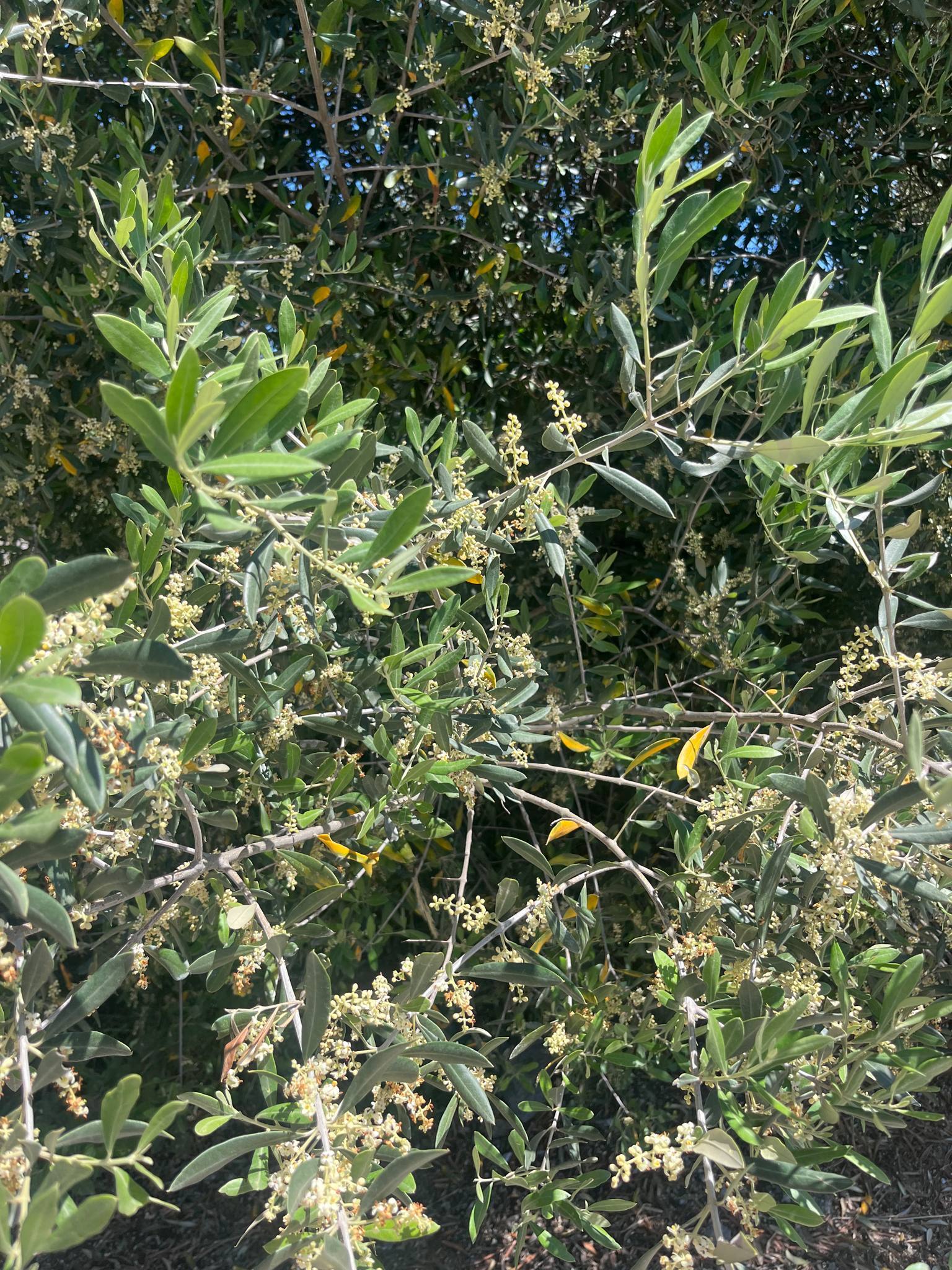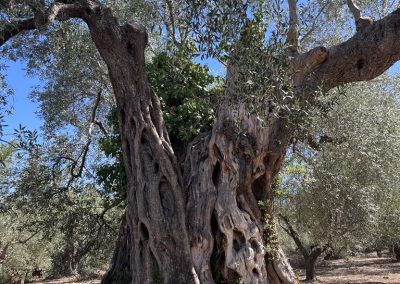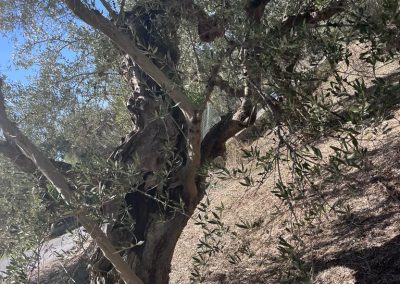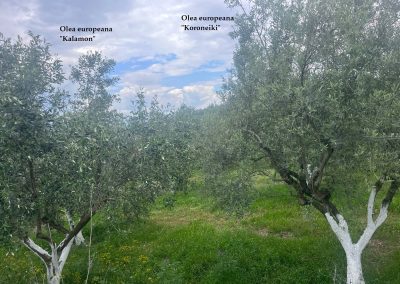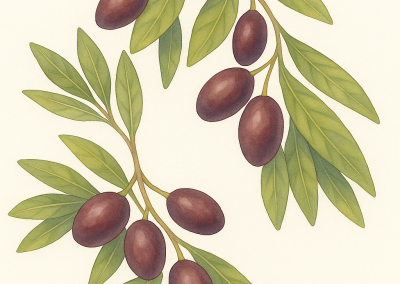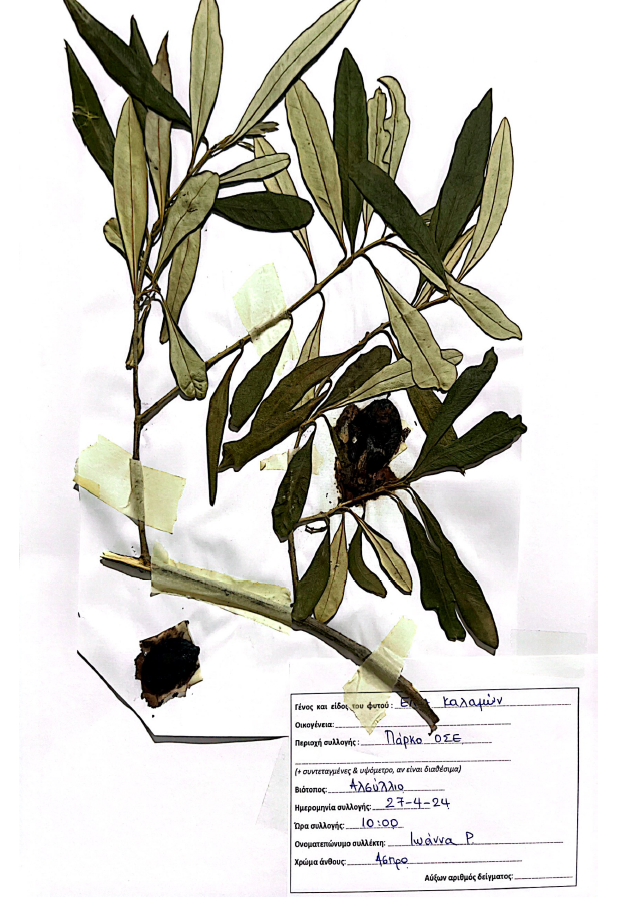Olea europea Kalamata
Scientific description
Scientific name: Olea europaea 'Kalamon' (Kalamata olive)
One of the best table varieties, used for the preparation of the world's best known and unique commercial type of edible olive. The tree is robust, its branches have a climbing tendency and large leaves. The fruit is cylindrical and resembles the grape variety; also called eagle's-nut Kalamata. Average fruit weight 5–6 g; kernel smooth and easily detached from the flesh. Moderately productive, demanding in soil and atmospheric moisture, resistant to soil salinity and verticillium. Ripens mid-early (end November–December).
The Kalamata olives are homogeneous but vary in color from chocolate to dark brown or violet, typically pointed, compact and crispy, with a distinctive fruity flavor that is also salty, slightly bitter and acidic. Eaten as is, in salads, especially in Greek village salad, and used in many recipes.
Επιστημονική ονομασία: Olea europaea 'Kalamon' (ελιά Καλαμών)
Μία από τις καλύτερες επιτραπέζιες ποικιλίες, που χρησιμοποιείται για την παρασκευή του γνωστού και μοναδικού εμπορικού τύπου βρώσιμης ελιάς. Το δέντρο είναι εύρωστο, τα κλαδιά έχουν αναρριχητική τάση και μεγάλα φύλλα. Ο καρπός κυλινδροκωνικός, μοιάζει με ρόγα σταφυλιού, ονομάζεται και αετονυχολιά Καλαμών. Κατά μέσο όρο 5–6 γρ., ο πυρήνας λείος και εύκολα αποσπάται. Δέντρο μέτριας παραγωγικότητας, απαιτητικό σε έδαφος και υγρασία, ανθεκτικό σε αλατότητα και βερτισίλιο. Ωρίμανση μεσοπρώιμη (τέλη Νοεμβρίου–Δεκέμβριο).
Οι ελιές Καλαμών είναι ομοιογενείς, χρώμα σοκολατί έως σκούρο καφέ ή ιώδες, μυτερές, συμπαγείς και τραγανές, με διακριτική φρουτώδη γεύση, αλμυρή, ελαφρώς πικρή και ξιδάτη. Τρώγονται ως μεζές, σε σαλάτες, ειδικά στη χωριάτικη σαλάτα και χρησιμοποιούνται σε πολλές συνταγές.
Nom scientifique: Olea europaea 'Kalamon' (olive de Kalamata)
L'une des meilleures variétés de table, utilisée pour préparer le type commercial d'olive comestible le plus connu et unique au monde. Arbre robuste, branches grimpantes, grandes feuilles. Fruit cylindrique, ressemble au raisin, appelé aussi noix d'aigle Kalamata. Poids moyen 5–6 g, noyau lisse et facilement détachable. Modérément productif, exigeant en sol et humidité, résistant à la salinité et verticilliose. Maturation mi-précoce (fin novembre–décembre).
Les olives de Kalamata sont homogènes mais varient du chocolat au brun foncé ou violet, typiquement pointues, compactes et croquantes, saveur fruitée distinctive, salée, légèrement amère et acide. Consommées telles quelles, en salade, surtout dans la salade grecque traditionnelle, et utilisées dans de nombreuses recettes.
Denumire științifică: Olea europaea 'Kalamon' (Kalamata olive)
Unul dintre cele mai bune soiuri de masă, folosit pentru cel mai cunoscut și unic tip comercial de măsline comestibile. Arbore robust, ramuri cu tendință de cățărare, frunze mari. Fruct cilindric, seamănă cu strugurii, numit și nuca vulturului Kalamata. Greutate medie 5–6 g, miez neted și se desprinde ușor. Moderat productiv, solicitant la sol și umiditate atmosferică, rezistent la salinitate și verticillium. Coacere semi-timpurie (sfârșit noiembrie–decembrie).
Măslinele Kalamata sunt omogene, culoare ciocolatiu → maro închis → violet, tipic ascuțite, compacte și crocante, aromă fructată distinctă, sărată, ușor amară și acidă. Se consumă ca atare, în salate, mai ales în salata grecească tradițională și folosite în multe rețete.
Creative writing inspired by Olea europea Kalamata
Olea europea 'Kalamon'
In the fertile plains surrounding the ancient city of Kalamata, there was a long-standing tradition of honoring the olive tree, a sacred gift from the goddess Athena. The olive tree was at the heart of people’s lives, providing food, oil, medicine, and standing as a symbol of peace and fertility. Among all the varieties of olives, one stood out, but its origin was wrapped in a unique legend.
Once, there lived a young farmer in Kalamata named Aristomenes. He was known for his deep love for the trees and the land, spending countless hours tending to his olive groves. However, despite his efforts, none of his trees bore the fruit he had hoped for. One evening, after a long day filled with disappointment, he lay down to sleep beneath an ancient olive tree, and in a deep slumber, he had a dream.
In his dream, the goddess Athena appeared to him and said, "Aristomenes, your patience and dedication to the land have not gone unnoticed. This olive tree beneath which you sleep is special, and it will bear the largest, juiciest, and most flavorful olives that the land of Kalamata has ever seen. From its fruits will come an olive and oil so exceptional that they will be renowned across the world."
When Aristomenes awoke, he rushed to care for the old olive tree. As time passed, its olives began to grow and stand out from all the others. The fruits were large, with a dark purple hue, and full of rich juices. The people of the region were amazed by their taste, and soon they began cultivating this tree with great care.
This olive became known as the Kalamon olive, named after the region where it was discovered. Its fruits, dark, glossy, and with a unique flavor, became a symbol of fertility and the blessing of the land. From then on, the Kalamon olive was revered and cherished not only in Greece but across the world, carrying with it the legend of Aristomenes and the blessing of the goddess Athena.


